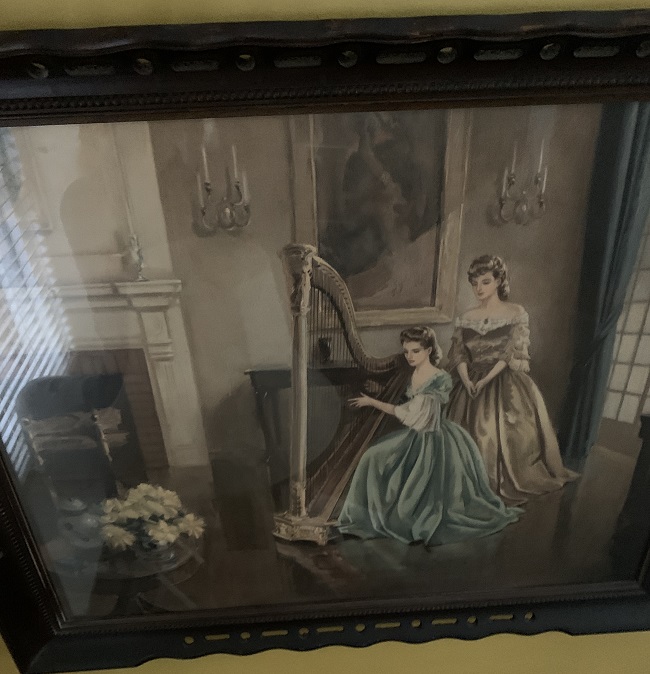By Raeleen D’Agostino Mautner
The only “works of art” in my grandparents’ modest home included a solitary mahogany-framed reprint of two ladies and a harp, circa 1800s, in the living room, a crafted analogue wall clock in the kitchen; and in the bedroom, a breathtaking purple mirrored crucifix that came from Italy. My grandmother taught us, through example, that in order to appreciate what you have, you can’t surround it with excess clutter. She felt the same way about her days, which she routinely divided into individual segments. For instance, she would set aside an hour and a half each day for only watching TV (i.e., learning English), then came an hour for concentrating on her rosary, next either a social visit, a phone call, or a “coerced” hour of listening to me play the guitar—and finally preparing la cena. Our home life was simple and serene and devoid of excessive mental, emotional, or physical clutter. Multi-tasking was not even a thing. We enjoyed the sensations of Giuseppina’s fragrant flower garden, her roasted potatoes, the Italian music that came from the radio—without being overwhelmed by a bombardment of sensory experiences all at once. The mantra was “non esagerare”; a reminder to keep even our emotional reactions to whatever life handed us, on an even keel. Often easier said than done!

As it turns out, an “exaggeration” of simultaneous information coming in through our senses can overwhelm the brain. We know of cases for example, where the sensory overload of videogames or cartoons have triggered seizures. But even beautiful artwork can be overwhelming to some, causing negative emotional and physical reactions. This perhaps is why Austrian poet and novelist Rainer Maria Rilke wrote in his Duino Elegies: “For beauty is nothing but the beginning of terror…”
In 1989, Italian psychiatrist Graziella Magherini coined the term “Stendhal Syndrome” (also known as the “Florence Syndrome”), after the French writer Marie-Henri Beyle, aka Stendhal. Stendhal spent some time in Firenze and filled his diaries with notes describing how overwhelmed and overcome he was when viewing the beauty of Italian works of art: “Everything spoke so vividly to my soul…I had palpitations of the heart…I walked with the fear of falling…”
Dr. Magherini noticed that Stendhal was not the only one to whom this phenomenon happened. Over 100 people, especially tourists to Italy, are on record as having experienced the same sense of overwhelm when surrounded by the beauty of certain artistic, or spiritual exhibits. Some have been hospitalized, with symptoms of dizziness, anxiety, mood disorders, feeling faint, or having heart palpitations. In rarer instances, some have even had symptoms of delusional or paranoid psychoses.
While Florence Syndrome is generally thought to be a psychosomatic illness (i.e., the mind having a direct effect on the body) the symptoms are never-the-less real, even if not considered an official diagnosis in the DSM. Afterwards, one can be left with lingering sadness or depression. This seems to happen, however, mostly to people who are sensitive to stimulation overload to begin with or may also have other conditions that make them more prone to such a reaction.
On the other hand, Dr. Piero Ferrucci, through his research and practice, is convinced that beauty can have a positive effect on us, for which he feels, bringing beauty into our lives is not an “extra”, but an essential. In his book Beauty and the Soul (La Bellezza e l’Anima) Ferrucci recounts how many of his patients, after being exposed to beauty (whether in art, music, nature, or a profound experience) felt regenerated with joy and a deeper knowledge. Beauty, as in artistic masterpieces, can touch us emotionally in a positive way, improve our mood, jog memory, create the transformational moment of a peak experience (Abraham Maslow) and even speed physical recovery. But as my grandparents knew, there is great wisdom in adhering to the guideline of moderation in all things.
In my opinion, too much of a good thing—in any area whether it be too much food, too much nightly news, too much spending, too much partying, or too much time alone, creates an imbalance and detracts from our overall well-being. Simplicity and balance are important guidelines to live by if we want to experience contentment. Thus, each day, if I catch myself going overboard in any area, I return to the lifestyle motto my grandmother lived by: “Non esagerare”!







